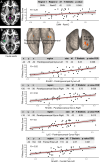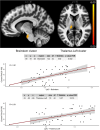The insula represents a key neurobiological pain hub in psoriatic arthritis
- PMID: 40165287
- PMCID: PMC11956455
- DOI: 10.1186/s13075-025-03526-7
The insula represents a key neurobiological pain hub in psoriatic arthritis
Abstract
Background: Pain remains a principal complaint for people with psoriatic arthritis (PsA), despite successful mitigation of inflammation. This situation alludes to the co-existence of distinct pain mechanisms. Nociceptive and nociplastic mechanisms are clinically challenging to distinguish. Advances in brain functional magnetic resonance imaging (fMRI) have successfully characterised distinct pain mechanisms across several disorders, in particular implicating the insula. This is the first study to characterise neurobiological markers of pain mechanisms in PsA employing fMRI.
Methods: PsA participants underwent a 6-minutes resting-state fMRI brain scan, and questionnaire assessments of nociplastic pain (2011 ACR fibromyalgia criteria) and body pain, assessed using the Numeric Rating Scale (NRS, 0-100). Functional connectivity between insula seeds (anterior, mid, posterior), and the whole brain was correlated with the above pain outcomes correcting for age and sex, and false discovery rate (FDR) for multiple comparisons.
Results: A total of 46 participants were included (age 49 ± 11.2; 52% female; FM score 12.5 ± 5.7; overall pain 34.8 ± 23.5). PsA participants with higher fibromyalgia scores displayed increased connectivity between: (1) right anterior insula to DMN (P < 0.05), (2) right mid and left posterior insula to parahippocampal gyri (P < 0.01 FDR); and (3) right mid insula to left frontal pole (P = 0.001 FDR). Overall pain was correlated with connectivity of left posterior insula to classical nociceptive regions, including thalamus (P = 0.01 FDR) and brainstem (P = 0.002 FDR).
Conclusion: For the first time, we demonstrate objectively that nociceptive and nociplastic pain mechanisms co-exist in PsA. PsA pain cannot be assumed to be only nociceptive in origin and screening for nociplastic pain in the future will inform supplementary analgesic approaches.
Keywords: Chronic pain; Fibromyalgia; Insula; Neuroimaging; Psoriatic arthritis.
© 2025. The Author(s).
Conflict of interest statement
Declarations. Ethics approval and consent to participate: The study received ethical approval from the West of Scotland Research Ethics Committee (ref 19/WS/0033). All participants provided written informed consent in accordance with the Declaration of Helsinki. Consent for publication: Not applicable. Competing interests: The authors declare no competing interests.
Figures




References
-
- Sumpton D, Kelly A, Tunnicliffe DJ, Craig JC, Hassett G, Chessman D, et al. Patients’ perspectives and experience of psoriasis and psoriatic arthritis: A systematic review and thematic synthesis of qualitative studies. Arthritis Care Res. 2020;72(5):711–22. - PubMed
-
- Rutter-Locher Z, Arumalla N, Norton S, Taams LS, Kirkham BW, Bannister K. A systematic review and meta-analysis of questionnaires to screen for pain sensitisation and neuropathic like pain in inflammatory arthritis. Semin Arthritis Rheum. 2023;61:152207. - PubMed
-
- Gudu T, Gossec L. Quality of life in psoriatic arthritis. Expert Rev Clin Immunol. 2018;14(5):405–17. - PubMed
-
- Terminology| International Association for the Study of Pain [Internet]. International Association for the Study of Pain (IASP). [cited 2023 Aug 21]. Available from: https://www.iasp-pain.org/resources/terminology/
MeSH terms
LinkOut - more resources
Full Text Sources
Medical
Research Materials
Miscellaneous

